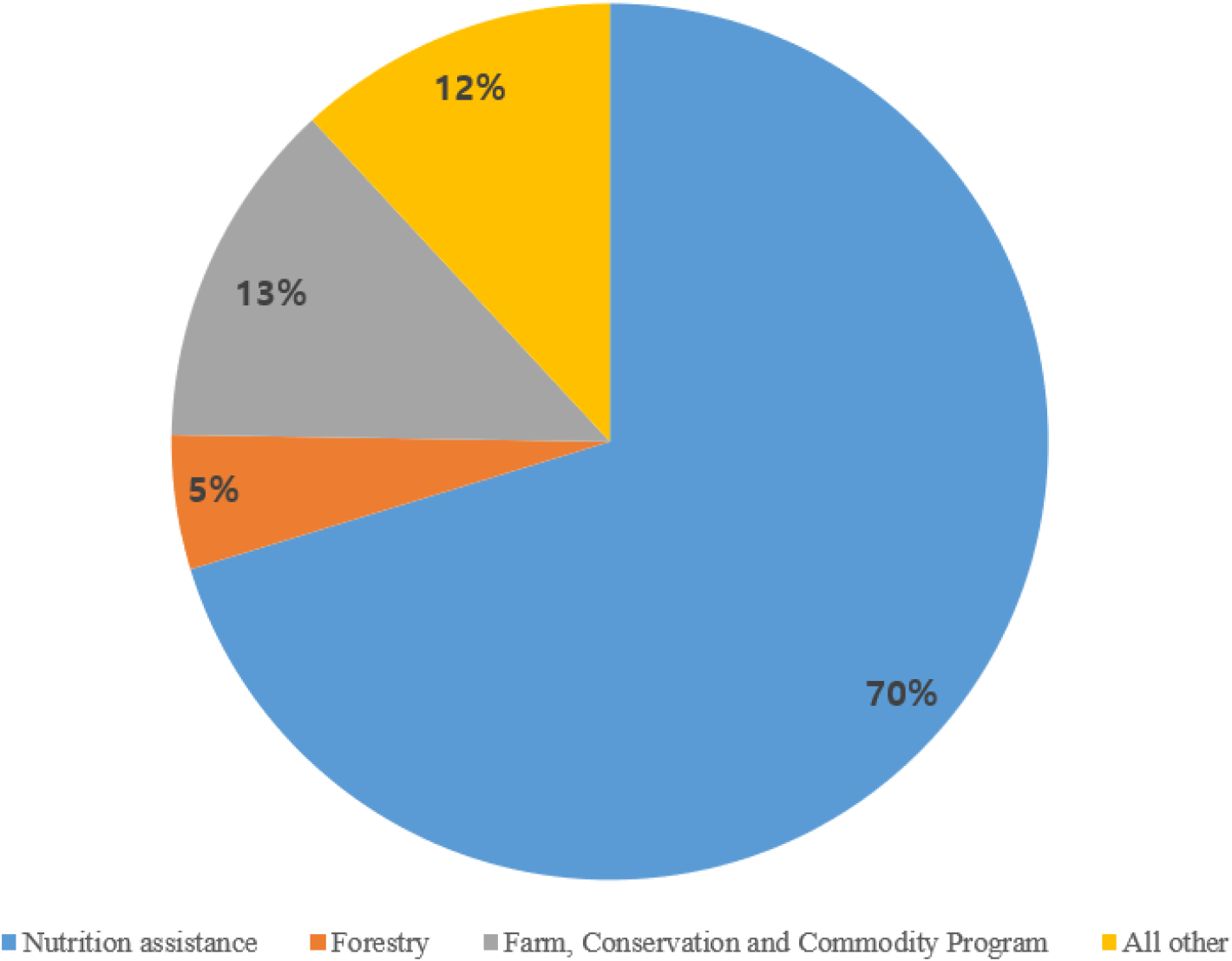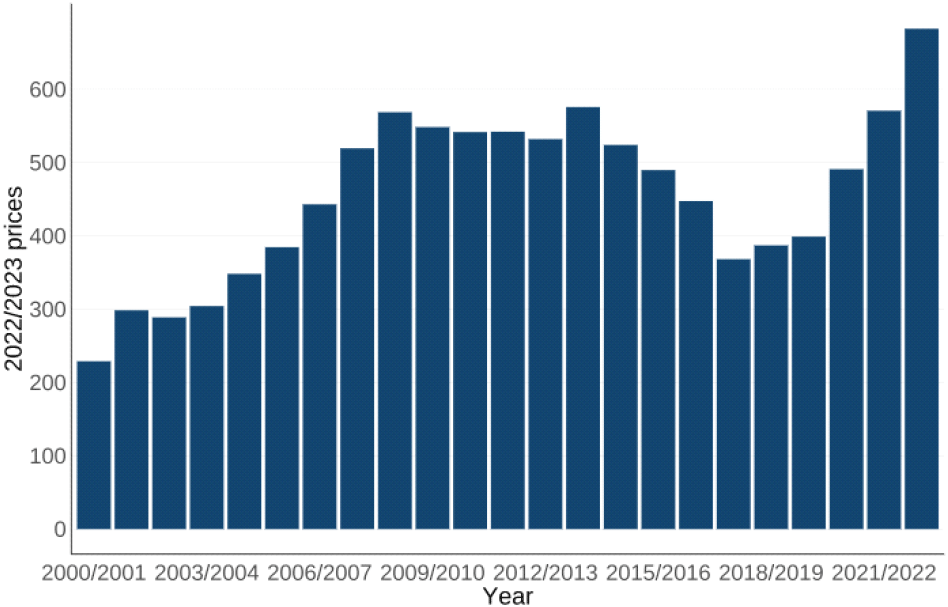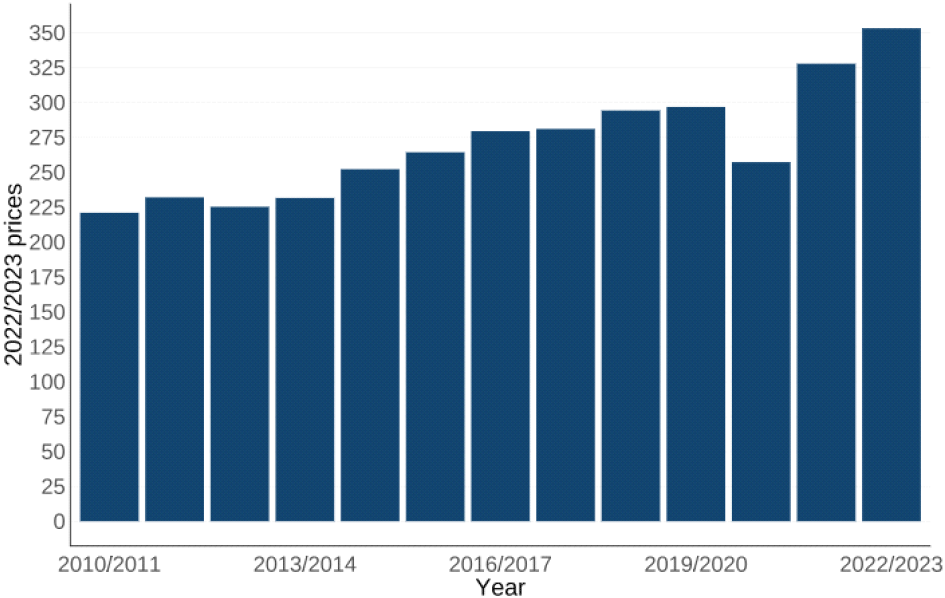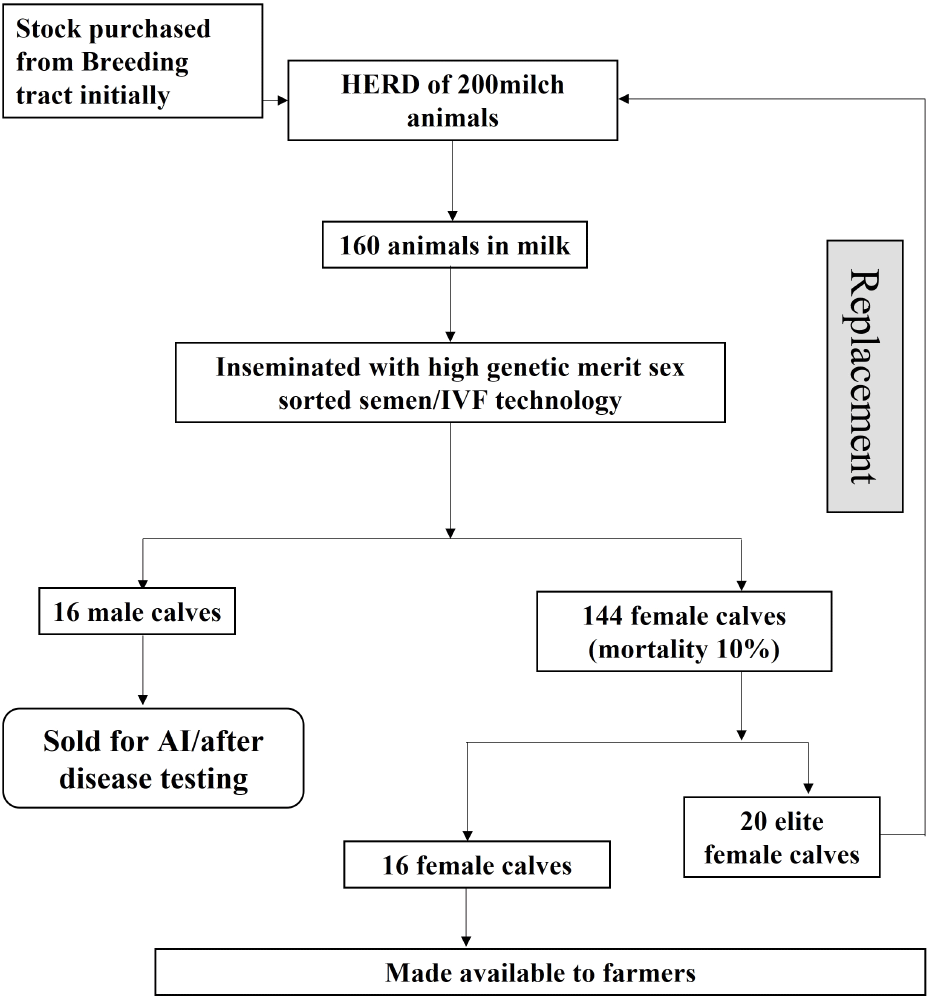서 론
생물 다양성은 생태계의 안정성과 인류의 생존을 위한 식량 안보와 경제 동물 육종을 위해 반드시 확보 및 유지되어야 한다(Hoffmann, 2011; Pozo et al., 2021; Dannenberg et al., 2024). 특히, 질병 저항성 품종 개발을 위해서는 다양한 자원을 활용할 필요가 있다. 현재 지구에는 약 3,000만 개의 생물 종이 존재하지만, 경제적으로 유용한 자원만 집중적으로 개발되고 필요 없는 자원은 버려져, 매년 0.01%의 생물 종이 멸실되고 있다(Halley and Pimm, 2023). 미국에서 소비되는 의약품의 25%가 자연에서 유래한다는 점을 감안할 때, 생물 종 멸실은 인류의 건강에 직접적인 영향을 미친다. 따라서, 인류에게 생물 종 보존은 매우 중요한 숙제이다(Keck et al., 2025).
2022년 FAO(Food and Agriculture Oraganization)의 세계 식량․농업 동물유전자원 현황(The State of the World’s Animal Genetic Resources for Food and Agriculture)에 따르면, 글로벌 데이터뱅크(Global Databank)인 가축다양성정보시스템(Domestic Animal Diversity Information System)에는 부속 영토(dependant territories)를 포함하여 총 182개 국가가 등록한 37개 축종의 유전자원 정보가 등록되어 있는 것으로 보고되었다. Table 1에 제시된 바와 같이 글로벌 데이터뱅크에 등록된 품종 개체 수는 2021년 15,115개에서 2022년 15,313개로 증가하였다. 또한, 포유류와 조류로 분류하여 개체 수를 비교한 결과, 2022년 9월 기준으로 조류는 61%에서 63%로 증가한 반면, 포유류는 2021년과 2022년 모두 동일하게 66%로 안정적으로 유지되고 있음을 알 수 있다(FAO, 2023).
Source: FAO (2023).
가축유전자원의 가치는 문화재 보존과 마찬가지로 인정받아야 하며, 이를 통해 경제적 가치를 실현하고 가축유전자원 관리 정책의 중요성을 강조해야 한다(Hoffmann and Scherf, 2005; Ovaska et al., 2021; Li et al., 2023). 선진국들은 이러한 가치의 중요성을 인식하고 있으며, 독일, 네덜란드, 호주 등은 관련 연구 및 개발을 활발히 진행하고 있다. 한국은 생명자원 관리의 중요성이 커짐에 따라 국제적인 협력 및 정책 분석을 통한 국내 동물 자원의 보존․관리 및 활용을 위해 GSP(Golden Seed Project) 사업과 같은 방안을 마련해왔다(Kang, 2017).
한편, 민간 부문과의 협력을 통한 생물 자원에 대한 법적 보호와 지속 가능한 관리 방안도 매우 중요한 부분으로 여겨진다. 따라서, 세계 각국의 축산물 및 유전자원에 관한 우수 사례를 토대로 우리가 나아가야 할 방향을 명확하게 설정하고 동물 유전자원 관리기관의 역할을 강화하여 축산 분야의 지속 가능한 발전을 이끌어 나가야 한다. 한국도 이와 관련된 지원책과 제도를 마련해야 할 필요성이 있다. 그러므로, 이 논문의 목적은 정보 공개가 잘되어 있는 선진국—유럽연합(EU), 일본, 중국 및 호주의 사례를 통해 한국의 가축유전자원 보존 정책의 방향을 수립하기 위해 해외 선진국의 동향을 파악하는 것이다.
주요 국가별 정책 현황
독일의 유전자원 관리 업무는 주로 독일 연방 농업 및 식품청(Bundesanstalt für Landwirtschaft und Ernährung; Federal Office for Agriculture and Food: BLE)에서 시행되고 있다. BLE는 독일 연방 식품 농업부(Bundesanstalt für Landwirtschaft und Ernährung und Landwirtschaft; BMEL) 산하 기관으로 1,700명의 직원과 생물 다양성 정보 및 조정 센터를 두고 있으며, 대통령 지휘 아래 운영되는 기관이다. BLE는 자금 조달 및 연구, 농산물 시장 및 무역 규제, 농촌 개발 등에 관한 업무뿐만 아니라 유전자 은행 관리 기관의 사무 업무도 담당하고 있다(BLE, 2017).
현재, 독일에서는 동물 유전자원의 다양성 보존을 위한 프로젝트를 시행하고 있으며, 각 프로젝트에서 시행되는 프로그램을 통해 자금 지원을 실시하고 있다. 독일의 GAP(Die Gemeinsamen Agrarpolitik; 공동농업정책) 전략 계획의 일환으로 농업환경, 기후 보호 및 동물 복지를 위한 자금 지원 프로그램(Förderprogramm für Agrarumwelt, Klimaschutz und Tierwohl; FAKT II)에서는 2023년 이후, 각 지역의 동물 유전자원에 관한 각종 조치가 제공되고 있다(Agrarpolitik and Förderung, 2024).
FAKT II의 목표는 생물 다양성의 보존과 개선 및 동물 친화적인 농업을 촉진하는 것이다. FAKT II에 따르면, 공공 지분이 25% 미만인 농업회사에 자금을 지원하며 자금의 출처는 EU와 연방 정부 및 바덴-뷔르템베르크(Land Baden-Württemberg; 독일 서남부에 위치한 주)이다. 동물 친화적 사육 절차로 시행되고, 최소 5년 동안 수행되어야 한다. 일반적으로 동물의 가치를 평가하여 지원 금액이 산정되며 품종이나 성별, 연령에 따라 차이가 현저하게 나타난다.
독일의 동물 유전자원 관리 및 보존을 위한 자금 조달 프로그램은 각 주에 따라 다양하게 제시되고 있으며(BLE, 2024), Tables 2 and 3에 정리하였다. 그 밖에 독일에서는 현지 외 수집의 이용에 따른 규정은 EU-ABS 규정에 따라 필요한 정보와 등록된 자료를 사용자에게 제공하도록 제도를 확립하고 있다. 지원금 산정 기준과 품종, 동물 종류 및 이용 방향에 따른 보조금 지원은 Tables 4 and 5와 같으며 EU 보조금 규정에 따라 10,000유로 이상의 보조금에 대한 정보를 공개하고 있다(STMELF, 2023).
| State | Species | Funding program | URL |
|---|---|---|---|
| Baden-Württemberg | cattle, pig, horse | Funding Program for Agri-environment, Climate Protection, and Animal Welfare. FAKT II | www.landwirtschaft-bw.info |
| Bayern | sheep, cattle, horse, goat | Promotion of Endangered Native Farm Animal Breeds | www.stmelf.bayern.de |
| Berlin | sheep, pig, cattle | Züchtung und Haltung vom Aussterben bedrohter lokaler Nutztierrassen; KULAP 2014 | mluk.brandenburg.de |
| Brandenburg | horse, sheep, goat, pig, cattle | Breeding and Keeping of Endangered Local Livestock Breeds. KULAP 2023 | mluk.brandenburg.de |
| Hessen | sheep, goat, pig, cattle, horse | Hessian Program for Agri-environment and Landscape Management Measures. HALM 2 | Agriculture.hessen.de |
| Mecklenburg-Vorpommern | pig, sheep, horse, cattle, | Guideline for the Promotion of the Conservation of Animal Genetic Resources in Agriculture | www.landesrecht-mv.de |
| Niedersachsen | cattle, chicken, horse, pig, goat, sheep, goose | Measures for the Conservation of Endangered Agricultural Livestock Species and Breeds | www.lwk-niedersachsen.de |
| Nordrhein-Westfalen | cattle, sheep, horse, pig, goat | Guidelines for the Promotion of Breeding and Keeping of Endangered Domestic and Livestock Breeds | right.nrw.de |
| Sachsen | pig, goat, cattle, sheep | Guideline of the Sachsen State Ministry for Environment and Agriculture for the Promotion of Animal Breeding | www.smekul.sachsen.de |
| Sachsen-Anhalt | horse, pig, cattle, sheep | Guideline on the Granting of Subsidies for the Conservation of Animal Genetic Resources in Agriculture | www.landesrecht.sachsen-anhalt.de |
| Schleswig-Holstein | horse, pig, cattle | State Measure | www.schleswig-holstein.de |
| Thüringen | horse, pig, sheep, goat, cattle | Endangered Native Livestock Breeds | infrastruktur-landwirtschaft.thueringen.de |
Source: BLE policies on the preservation and sustainable use of animal genetic resources (Förderung Tiergenetischer Ressourcen).
| Item | Description |
|---|---|
| Eligibility | |
| Objective | |
| Eligible breeds (recorded genetic resources) | |
| Commitment period & 30% Rule | |
| Breed recording details | |
| Beneficiary obligations |
Source: Merkblatt (2023); https://www.stmelf.bayern.de/foerderwegweiser
Source: Merkblatt zur Erhaltung gefährdeter einheimischer landwirtschaftlicher Nutztierrassen; Merkblatt (2023).
독일의 FAKT II와 같은 정책은 단기적 성과에 집중하기보다 장기적이고 안정적인 재정 지원을 통해 생물다양성 보존이라는 목표를 꾸준히 추구한다는 점에서 주목할 만하다. 이는 일시적이거나 단기 프로젝트 위주인 한국의 지원 방식과 대조되며, 국내 가축유전자원 정책이 지속가능성을 확보하기 위해 나아가야 할 방향을 보여준다.
미국 연방 행정부의 부처인 미국 농무부(United States Department of Agriculture; USDA)는 농지 개발, 농업, 임업, 축산업, 식품에 대한 정책을 담당한다. USDA의 예산 요약(budget summary) 보고서에 따르면, 2024년 USDA 프로그램 및 운영 비용을 지원하기 위한 재량 예산 요청은 326억 달러로 2023년 재정 수준보다 약 16.9% 증가한 금액이다. USDA 예산 배분 분야는 Fig. 1과 같다(USDA, 2024a).

USDA는 2023년 농업 법안 보전 프로그램(Farm Bill Conservation Programs)에 따라, 건강한 숲 보호 프로그램(Healthy Forests Reserve Program)에 2,000만 달러를 지원하였으며 개인 소유의 토지와 인디언 소유의 토지를 등록하여 숲을 복원, 향상 및 보호하여 식물 및 동물의 생물 다양성을 개선하고 멸종위기종 법안에 따라 멸종위기 및 위협종의 회복을 촉진하는 데 목적을 두고 있다(USDA, 2024b).
USDA의 연구 부서인 농업 연구 서비스(Agriculture Research Service; ARS)는 가축 생산 및 가축 보호를 위한 프로그램을 시행하고 있으며, 가축 생산에 관한 프로그램에서는 다음과 같은 방향으로 진행되고 있다.
-
동물 유전자원 보호 및 활용
-
동물 유전자원 관련 유전자 및 유전체 데이터베이스와 생물 정보학 도구 이용
-
가축과 가금류의 생리학 기초 이해 및 개발
-
동물 생산 시스템 개선을 위해 사용할 수 있는 정보, 도구 및 기술 개발
ARS의 가축 보호에 관한 프로그램은 질병 탐지, 예방, 통제 및 치료의 개선을 통해 국가 농업과 식품 공급의 안전을 보장하는 데 중점을 두고 있다. 가축 생산 및 가축 보호를 위한 프로그램의 예산은 Table 6과 같다.
| Item | 2022 Actual | 2023 Enacted | 2024 Budget |
|---|---|---|---|
| Livestock production | 134 | 144 | 151 |
| Livestock protection | 144 | 153 | 162 |
특히 미국 농업 연구 서비스(ARS)의 체계적인 데이터베이스 구축 및 활용은 단순한 자원 보존을 넘어 산업적 가치 창출로 이어지는 선진적 모델이다. 유전자원 정보가 분산되어 있고 통합적 활용이 미흡한 한국의 실정에서, ARS와 같은 국가 차원의 데이터 관리 및 정보 제공 시스템 구축은 국산 품종 개발과 산업 경쟁력 강화를 위해 시급히 벤치마킹해야 할 부분이다.
FAO의 농장 동물 유전자원(Farm of Animal Genetic Resource; FAnGR) 글로벌 행동 계획이 2007년에 수립된 이후, 영국의 FAnGR 보존을 위한 정책이 부족한 것으로 평가되었다(Ahmadi and Peart, 2018; Pert et al., 2019). 브렉시트(brexit)로 인해 농업 정책이 재정의되면서, FAnGR은 공공의 이익을 위한 중요한 환경 서비스로 재조정되고 자금 지원이 증가하고 있다. 이를 통해 글로벌 행동 계획의 목표를 달성하고 미래의 가축 유전자 자원을 효과적으로 보존할 수 있어야 함을 제시하고 있다(Cao et al., 2021).
영국에서 시행되고 있는 가축 유전자원 보존과 유지를 위한 사업으로는 RBST(Rare Breeds Survival Trust)가 2022년 경마위원회(Horserace Betting Levy Board)의 자금을 지원받아 말 보호 프로젝트(Equine Conservation Project)를 시행하고 있는 사례가 있다(RBST, 2024). 이 프로젝트의 목적은 3년간 두 분야로 구성된 프로그램을 통해 토종말 품종의 보존 상태를 개선하고, RBST의 사육자에 대한 지원 능력을 향상시키는 것이다. 첫 번째, 품종별 문제를 식별하고 번식 및 생식 기술을 발전시키고, 두 번째는 품종의 용도를 다양하게 함과 동시에 개체 수를 증가시키는 데 중점을 두는 것이다. RBST는 사육자로부터 수집한 데이터를 분석하여 필요한 정보 영역을 식별하고, 이를 바탕으로 사육자에게 유용한 가이드를 제작하여 지원 및 제공하고 있다.
스코틀랜드 정부의 RESAS(Rural and Environment Science and Analytical Services Division) 프로그램에서는 RBST의 보존 계획에서 시행되고 있는 프로젝트의 하나인 North Ronaldsay 양 축군의 보존 및 유지를 위한 유전체 연관 연구를 지원하고 있으며, 이 연구 결과의 동물 유전형 데이터는 유전체 근친 교배 수준을 포함한 유전적 다양성에 대한 여러 측정치를 도출하는 데 유용하게 사용되고 있다(Banos, 2023).
영국의 환경식품농무부(Department for Environment, Food and Rural Affairs; DEFRA)에서는 소, 양, 염소, 말, 돼지, 가금류의 농장 동물 유전자원과 관련된 연구 프로그램을 2009년과 2012년~2013년 시행하였다(Defra, 2012). 2012년부터 2013년까지 시행된 FAnGR 보존 전략 및 구현 지침의 현장 내 및 현장 외 개발을 위한 프로젝트는 FAnGR의 유전적 보존 현황을 평가하고, 보존 전략과 육종 프로그램의 모범 사례를 개발하고자 노력하고 있다. 또한, EU 농업 및 농촌 개발 정책이 FAnGR에 미치는 영향을 검토하여 정책 입안자들에게 필요한 정보를 제공하고 있다. 이 프로젝트에는 유전적 변이 보존과 동물 식별 및 추적 가능성의 중요성을 강조하며, 이를 통해 과학적 지식을 반영한 사용자 친화적인 지침서를 제작하는 것이 주목표이다. Table 7은 영국 DEFRA의 과학 및 연구 프로젝트 검색을 통해 확인된 FAnGR 프로젝트에 관한 기간과 비용에 관한 내용이다. FAnGR은 2022년 6월 권한 범위가 확대됨과 동시에 UK Genetics for Livestock and Equines Committee(UKGLE)로 변경되어 농장 동물 유전자원의 보존 및 지속 가능한 이용과 모든 문제에 대해 행정부에 자문을 제공하고 있다.
영국의 공식 통계 자료인 생물 다양성을 위한 자금 지원 2023년 보고서에 제시된 공공 및 비정부 기구의 지출 금액은 Figs. 2 and 3과 같다(Defra, 2024).


영국의 RBST는 정부의 재정 지원과 민간의 전문성 및 현장 네트워크가 결합된 성공적인 민관 협력 사례로 평가된다. 정부 주도 사업의 한계에 부딪히곤 하는 한국의 상황에서, 생산자, 연구기관, 관련 협회 등이 주도적으로 참여하는 RBST 모델을 국내 실정에 맞게 도입한다면 보다 효율적이고 현장 중심적인 유전자원 보존 및 관리 체계를 구축할 수 있을 것이다.
인도의 가축 사육은 전통적인 생계 수단으로 농업 경제와 밀접하게 연결되어 있다(Priyadarshini et al., 2024). 인도는 약 1억 9,090만 마리의 소를 보유하며, 이는 세계 소의 14.5%에 해당한다. 이 중 80%인 1억 5,100만 마리가 토종 소이며 국가 인정 완료된 39종의 토종 소 품종과 13종의 물소 품종이 포함된다. 토종 소는 고온 내성 및 질병 저항성이 뛰어나 극한 환경에서도 생존할 수 있는 능력을 갖추고 있다. 따라서, 인도 정부는 가축 및 동물 유전자원 보존과 개발을 위해 다수의 예산을 책정하고 있으며 이는 주요 경제 활동에 큰 기여를 하고 있다(Government of India, 2023).
인도에서 시행되고 있는 동물 유전자원에 관한 주요 프로그램은 인도 정부 기관인 동물 사육 및 낙농부(Department of Animal Husbandry and Dairying; DAHD)에서 시행 및 집행 관리하며 2022년~2023년도 계획 예산에는 동물 사육 및 수의 서비스, 라슈트리아 크리쉬 비카스 요자네(Rashtriya Krishi Vikas Yojane, RKVY) 프로젝트를 포함해 총 2,498억 4,431만 루피가 할당되었다. 이 예산에는 가축 유전자원의 보호, 개량, 연구를 위한 다양한 프로그램이 포함되어 있다(MoFAHD, 2024).
국가 고쿨 미션(Rashtriya Gokul Mission)은 토종 품종의 보존과 개발을 과학적이고 체계적으로 추진하기 위해 2021년~2026년까지 수행되고 있다. 2021년~2026년 동안 2,400억 루피의 예산으로 운영되며 주요 목표는 유우 생산성 증가 및 농가 수익성 향상이다(MoFAHD, 2024).
인도의 정부기관인 DAHD의 보고서에 따르면 토종 소 및 물소의 사육과 보존 즉, 동물 유전자원의 보존과 가축 생산성 향상을 위해 지속 가능한 방식으로 생산량 증대를 위한 번식 네트워크를 강화 및 고유 전형 수소의 보급을 원활하게 하고자 한다고 밝혔다(MoFAHD, 2022).
인도의 우수한 토종 유우 품종이며 기후 변화의 영향을 가장 적게 받는 Gir, Sahiwal, Rathi, Deoni, Tharparkar, Red Sindhi를 이용하여 본 계획을 수행하였다. IVF 방법으로 임신한 소는 5,000루피의 보조금이 참여 농민에게 지급되며, 품종 개량 농장(breed multiplication farm; BMF) 설립 기업에는 프로젝트 자본 비용의 최대 50%가 지원된다(MoFAHD, 2022).
인도는 선진국에 비해 인공수정 기술자의 부족으로 AI 적용률은 전체 가축의 30%에 불가하여 AI 적용 확대를 위한 AI 기술자 양성을 위한 제도인 Multi Purpose Artificial Insemination Technicians in Rural India (MAITRIs)를 도입하고 있으며 기술자 양성을 위한 지원금은 Table 8과 같다(MoFAHD, 2022). 그 외의 Rashtriya Gokul Mission에서 시행하는 관련 프로그램과 관련 프로그램의 예산 재정은 Table 9와 같다. 상기 언급된 프로젝트의 품종 개량 농장 설립 모델 프로젝트(BMF Entrepreneurship model project)에 관한 내용은 Fig. 4와 같다.

| Item | Cost (Rs) |
|---|---|
| Traing cost | 31,000/trainee |
| Equipment for cryopreservation | 50,000/trainee |
캐나다는 UN 생물 다양성 협약에 따라 새롭게 채택된 글로벌 목표에 대응하여 국내 생물 다양성 목표를 수립했다. 이러한 목표에는 2025년까지 캐나다 육지의 4분의 1과 바다의 4분의 1을 보존하고 2030년까지 30%를 보존하기 위한 노력이 포함된다. 캐나다 정부는 위험에 처한 종을 위해 보다 건강한 서식지를 조성하고 캐나다의 자연환경을 개선하는 것을 포함하여 조력자와 함께 이러한 목표를 달성하기 위해 노력하고 있다(Eckert et al., 2023).
캐나다 농업 및 농식품부(Agriculture and Agri-Food; AAFC)는 혁신과 경쟁력을 촉진하는 사업을 통해 캐나다 농업 및 농식품 부문을 지원한다. AAFC는 캐나다 농업 부문과 생산자, 가공업체를 지원하기 위한 새로운 사업을 지속적으로 추진하고 있다. 대표적인 AAFC의 사업으로는 지속 가능한 캐나다 농업 파트너십(Sustainable Canadian Agricultural Partnership; Sustainable CAP), 캐나다의 식품 정책 그리고 청소년 및 젊은 농업인을 위한 프로그램과 교육 등이 있다.
Sustainable CAP은 35억 캐나다 달러 규모의 5년 계약(2023년 4월 1일~2028년 3월 31일)으로 농업, 농식품 및 농산물 부문의 경쟁력과 혁신 및 회복을 강화하는 것을 목표로 한다. 이 계약은 연방정부(federal government) 프로그램의 10억 달러와 주정부 및 준주정부(provincial and territory governments)가 공동으로 자금을 지원하는 비용 공유 프로그램 및 활동 25억 달러의 지원금을 포함하고 있다(Agriculture and Agri-Food Canada, 2023). 특히 캐나다에서는 Sustainable CAP에 따라, 생산자가 농장의 생존을 위협하는 위험을 관리할 수 있는 비용을 정부가 관리 프로그램 비용을 지원하며 이때 자연재해에 대한 농업보험을 제공한다. 특히, 캐나다에서는 소와 돼지의 예상치 못한 가격 하락에 대한 보호를 제공하는 보험 제도 규정도 명확하게 확립되어 있다. 각 주 또는 준주의 관리 기관을 통해 지역 프로그램 및 서비스를 확인할 수 있다.
Results Driven Agriculture Research(RDAR)는 캐나다 서부 앨버타 농업의 수익성, 생산성, 경쟁력 및 지속 가능성을 강화하고, 생산자 주도의 결과 중심 농업 연구에 대한 전략적 투자를 목표로 하며, 관련 자금은 앨버타 주 정부와 캐나다 정부에서 Sustainable CAP을 통해 지원된다.
농업 자금 컨소시엄(Agriculture Funding Consortium; AFC)은 캐나다 서부의 농업 연구 자금 지원을 위한 원스톱 서비스이다. 2023년~2024년 AFC가 지원한 동물에 관한 자금(AFC Investments 2023/2024)은 Table 10과 같다(Agriculture Funding Consortium, 2024).
한편, 캐나다 공원 관리국은 자연 및 생물 다양성 보존을 위하여 국가 생태 통로 프로그램(National Program for Ecological Corridors)을 시행하고 있다. 생태 통로는 야생동물과 식물 종이 이동할 수 있는 통로로, 서로 분리된 서식지를 연결하여 생물 다양성을 유지하고 생태계의 건강성을 증진시키는 역할을 한다(Beazley et al., 2023). 이 프로그램은 약 6천만 달러의 지원금으로 운영되며 정부와 전문가 및 원주민이 협력하여 생물 다양성 보호를 위한 기준을 개발하는 것을 목표로 하며, 동물 종이 생태계 변화와 기후에 적응하도록 돕는 방식으로 진행된다(Government of Canada, 2024).
캐나다의 Sustainable CAP은 연방 및 주 정부가 협력하여 5년 단위의 장기적이고 포괄적인 지원 체계를 구축했다는 점에서 의미가 크다. 이는 정책의 예측 가능성을 높여 농가들이 안정적으로 유전자원 보존 활동에 참여하도록 유도한다. 이러한 장기적 파트너십 접근은 국내 정책 수립 과정에서도 중요한 참고 모델이 될 수 있다.
프랑스의 동물 유전자원 관리 조직은 농식품부(Ministry of Agriculture and Food Sovereignty; MASA) 정부 기관 산하의 프랑스 농업, 식품 및 환경 국립연구소(National Research Institute for Agriculture, Food and Environment; INRAE, FranceAgriMer)이며 멸종 위기 품종의 보호를 위하여 EUCAP과 국가 지원 프로그램(프랑스 CAP 계획, 2023~2027)을 이용하여 생체 내(in vivo) 보존을 위한 지원 전략을 시행하고 있다. 멸종 위기 품종으로 분류된 축종은 순종 교배를 조건으로 자금을 지원받는다. FranceAgriMer는 농업을 담당하는 부처의 감독을 받는 공공 행정 기관으로 데이터 수집 및 분석, 국가 기금 지원금 지급을 수행한다.
국가 지원 프로그램에 의한 생체 내 보존의 경우, 반추류 및 말 품종 협회에 대한 지원과 인공 수정 관련 지원금도 모두 지역화된 멸종 위기 품종에 특별히 초점을 맞춰 제공되고 있으며 Table 11에서 관련 내용을 확인할 수 있다(ERFP General Assembly, 2023).
결론 및 고찰
현재 우리나라는 가축유전자원 관련 지원이 상대적으로 미비하며, 영세 농가를 위한 지원책과 제도가 필요한 실정이다. 특히 가금 자원 분야에서는 소규모 농가의 지속 가능성이 심각하게 위협받고 있어 국가의 정책적 지원과 관리가 필요하기 때문에 해외 선진국의 사례를 통해 예산 확보의 근거를 마련해야 한다. 예를 들어, 독일의 FAKT II나 캐나다의 Sustainable CAP은 안정적인 공공 재원을 바탕으로 장기적 지원의 중요성을 보여주며, 이는 단기 과제 중심인 국내 지원 체계가 나아가야 할 방향을 제시한다.
현재 농가 가축유전자원 중 일부는 체계적으로 관리되지 않아 소실되고 있으며, 지속적 지원이 요구된다. 따라서, 정부는 제주도의 재래돼지와 제주마를 지정 관리하여 보존하고 있는 사례와 같이 특정 농가를 선정하여 지속적으로 지원하는 방안을 검토해야 한다.
현재 42개 축종 중 35개 축종을 대상으로 유전자원 발굴 프로젝트가 진행되고 있으며 이 과정에서 토착 품종의 중요성이 점차 부각되고 있다. 가축유전자원은 높은 경제적 가치를 지니고 있으며 국제적 특허 체계가 미비한 상황에서도 활발한 거래가 이루어지고 있다. 민간 부문의 연구 개발이 국가 주도의 연구를 앞서는 경향이 나타나고 있어 정부는 민간의 연구 역량을 활용하고, 이들이 필요로 하는 지원이나 규제를 마련하고 변화에 대응하는 정책 개발이 필요하다.
호주와 같은 선진국에서는 육류 수출이 민간 주체의 주도로 이루어지고 있으며, 관련 협회가 마케팅 및 지원 활동을 활발히 수행하고 있다. 따라서, 우리나라도 이러한 민간 자조금 제도를 확대할 필요성이 있다. 특히 영국의 RBST(Rare Breeds Survival Trust)와 같이 정부, 연구기관, 생산자가 유기적으로 협력하는 민관 파트너십 모델을 국내에 도입하여, 정부 주도 지원의 한계를 보완하고 현장의 참여를 이끌어내는 방안을 적극 모색할 필요가 있다. 현재 우리나라의 농가들은 국가의 지원 및 관리 부족으로 인해 경영 위기에 직면해 있다. 이에 따라, 해외 성공 사례를 바탕으로 농가 지원 정책을 체계적으로 수립해야 한다. 뿐만 아니라, 가축유전자원의 체계적 관리 및 보존을 위해 축종별로 보다 정밀한 데이터 수집이 필요하다. 미국의 농업 연구 서비스(ARS)가 유전자원 데이터를 체계적으로 수집․분석하여 산업적 활용을 촉진하는 것처럼, 이러한 데이터 기반의 접근은 국산 품종 개발 및 보급을 통해 수입 종자에 대한 의존도를 감소시키는 핵심 전략이 되어야 한다. 특히, 가금 유전자원은 대부분 수입에 의존하고 있어 심각한 문제가 되고 있다. 이를 해결하기 위해 산란계와 육계의 국산 품종 개발이 시급하며, 민간과의 협력을 통해 자원 관리 및 지원 체계를 구축해야 한다.
결론적으로, 농가 가축유전자원 보존과 경제적 가치를 연결짓는 정책이 요구되며, 이를 위해 다양한 사례와 데이터를 활용해 지속적으로 개선해야 한다.
적 요
생물다양성은 생태계 안정, 식량 안보, 가축 육종에 필수적이나, 많은 유전자원이 소실될 위기에 처해 있다. 이에 본 연구는 세계 주요 국가(독일, 미국, 영국, 인도, 캐나다, 프랑스)의 가축유전자원 보존 정책 및 국제 동향을 비교 분석하여 대한민국 정책 발전을 위한 방향을 제시하고자 한다. 이를 위해 각국의 제도적 체계, 재정 지원, 주요 보존 사업을 공식 보고서와 연구 논문 등을 통해 종합적으로 검토하였다. 분석 결과, 주요 선진국들은 안정적 공공 재원을 통한 장기 지원(독일 FAKT II, 캐나다 Sustainable CAP), 민관 협력을 통한 멸종위기 품종 보존(영국 RBST), 그리고 데이터 기반의 체계적 관리 및 활용(미국 ARS)이라는 공통된 전략을 보였다. 이러한 세계적 우수 사례를 바탕으로, 국내 유전적 다양성 보존을 위해서는 안정적 예산 확보, 효과적인 민관 협력 모델 도입, 데이터 기반 관리체계 고도화 등 체계적인 지원 정책과 제도의 구축이 필수적임을 제언한다.








